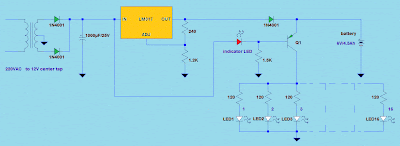Solar Charger Circuit by LM317

Here is a solar charger circuit is used to charge lead acid batteries or Ni-Cd with solar power. Circuit harvests solar energy to charge a 6 volt battery 4.5 Ah battery for various applications. The charger has voltage and current regulation and voltage cut-off facilities. The circuit uses a 12 volt panel solar energy and a variable voltage regulator IC LM 317. The solar panel consists of solar cells each rated at 1.2 volts. 12 volt DC is available from the panel to charge the battery. Load current flows through D1 to the voltage regulator IC LM 317. By adjusting the adjustment pin, voltage and output current can be regulated. VR is placed between the adjustment pin and ground to provide an output voltage of 9 volt battery. Restrict resistance R3 load current and the diode D2 prevents the discharge of the battery current. Transistor T1 and zener diode ZD act as a cutoff switch when the battery is full. Usually T1 is off and the battery current load. When the voltage at th...



